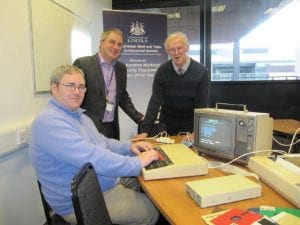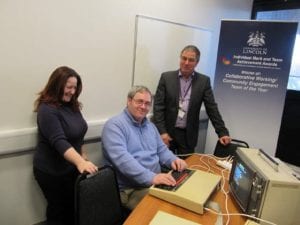Local Lincoln resident Eric Hair had no further use for his old BBC Model B microcomputer so telephoned the School of Computer Science to see if it would be of interest. Head of School, David Cobham was quick to agree to accept the thirty year old device and along with Senior Lecturer John Murray helped Eric to transport the computer and various peripheral devices to their new home in the School.
“The moment we connected everything and switched it on was completely magical”, Dr Cobham reported. “Without a snag, the familiar two-tone beep was played and the computer fired up with its familiar white text on a predominantly black background”.
The computer, manufactured by Acorn in the early 1980s, was the first microcomputer to be used in large volumes in secondary schools and colleges. At the time Dr Cobham was starting out as a novice lecturer tasked to introduce the emerging computer science curriculum and Dr Murray was a pupil seeing computers being introduced in schools for the first time. The computer was adopted by the BBC to support a series of television programmes that were produced at the time to herald the new world of “home computing” that mushroomed as microprocessors and memory chips became small and inexpensive enough to be put into a desktop machine. The computer was a masterpiece of innovation and was constructed in a flexible and extensible way to allow future enhancement in a range of different applications. Home users like Mr Hair were quick to see the possibilities of a home device that could be used for word processing, for recording finances on spreadsheets and to help his children with their homework and school studies.
The BBC Model B was cleverly designed with the operating system burnt onto a ROM chip – that means there is no lengthy wait for the computer to boot up. Additional slots for further ROM chips meant that applications like a word processor or a database could also be held on ROM chips keeping the limited amount of RAM completely free for the user’s data. The computer was shipped with only 32K of RAM, which seemed huge at the time but is a millionth of the memory of today’s desktop machines. External storage was via cassette tapes or, later on, using 5.25” floppy disks.
As well as being used in schools and small businesses the BBC computer also had relatively sophisticated sound capabilities and a number of the School of Computer Science’s current lecturers used the “6502” microprocessor driven machine to encourage student projects to create drum machines, synthesizers and even to programme banks of computers to play in a mini-orchestra emulating the newly emerging electronic music of the day by the Human League and New Order.
The computer was eventually superseded by “IBM compatible” PCs produced ever cheaper by companies like Amstrad which meant that students in education moved away from the BBC B and were finally using the same technology and software as those in business and industry.
“The BBC B generated a great deal of affection amongst those who used it”, says Dr Cobham. “We are extremely grateful to Mr Hair for his generous donation. We will put it on show in our display cabinet but I suspect a large number of people will be borrowing it to fire it up and take a stroll down memory lane.”

